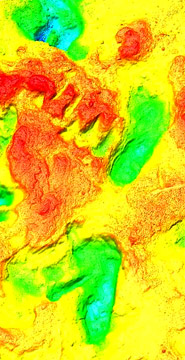From: Berhane Habtemariam (Berhane.Habtemariam@gmx.de)
Date: Fri Feb 27 2009 - 08:38:09 EST
Footprints of ancient Man point the way out of Africa
Human footprints identified as oldest prints left by feet with recognisably
modern anatomy have been discovered in Africa
An optical laser scan showing three 1.5 million year old footprints (in
green)
(Professor Matthew Bennett, Bournemouth University)
The green prints on an optical laser scan indicate a modern, efficient
stride
Mark Henderson, Science Editor
February 27, 2009
A remarkable set of human footprints from 1.5 million years ago has been
discovered in Africa, suggesting that the human feet of ancient times walked
much as we do today.
Three tracks found near Ileret in northern Kenya have been identified as the
second oldest made by prehistoric human relatives and the oldest prints left
by feet with a recognisably modern anatomy.
The find casts important new light on the evolution of humanity's upright
stride, suggesting that Homo erectus, an ancestral species that emerged
about 1.8 million years ago, walked with an upright gait little different
from our own.
Homo erectus is thought to have been the first species of ancient humans to
migrate out of Africa and its efficient, two-legged biomechanical style may
have been critical to this, scientists said.
The Ileret discovery is the first of ancient human footprints since the
famous Laetoli tracks, from 3.75 million years ago, were discovered in
Tanzania in 1978 by a team led by Mary Leakey.
While the Laetoli tracks confirmed that some ancestral humans, or hominins,
could walk upright on two legs, the Ileret footprints are the earliest that
reveal an anatomy and stride that is unambiguously adapted for a bipedal
gait.
Australopithecus afarensis, the primitive human relative that walked at
Laetoli, had a splayed big toe similar to that of apes and scientists
disagree whether it was exclusively bipedal or sometimes walked on its
knuckles like modern chimpanzees.
By contrast, the Ileret prints, which were probably made either by Homo
erectus or a subspecies called Homo ergaster, reveal an anatomy almost
indistinguishable from that of Homo sapiens.
They show a big toe parallel to the other toes, a large and robust heel, a
high arch and short toes, all of which are characteristic of modern humans.
This points towards an upright gait that we would recognise as very similar
to our own.
Matthew Bennett, of Bournemouth University, who led the study team, said the
find was particularly important because no Homo erectus foot bones survive
in the fossil record.
"Carnivores are partial to hands and feet, so nothing was preserved," he
said. "We knew its anatomy was adapted for bipedalism, but we knew nothing
about a critical element of its biomechanics: its feet.
"Now we know that 1.5 million years ago, Homo erectus had feet with an
anatomy very similar to modern humans. It could essentially walk with the
same biomechanical efficiency as you or I."
He added that the species's bipedal locomotion could have made it possible
for Homo erectus to migrate beyond Africa. "It was adapted for long-distance
walking," he said.
The ancient footprints, details of which are published in the journal
Science, were found in two different layers of sediment. The upper one
includes two trails of two prints, one trail of seven prints, and several
isolated prints, while the lower layer has preserved one trail of two prints
and another single print, probably left by a juvenile.
All the prints have been reliably dated to between 1.51m and 1.53m years ago
from the age of the volcanic ash embedded in the rocks in which they were
found.
Professor Bennett's team has scanned the prints using a laser technique to
create detailed models that allow them to be studied without damaging them.
These scans have exposed the remarkably modern anatomy of the feet that made
the prints.
Brian Richmond, of George Washington University in Washington, DC, a member
of the study team, said: "The discovery of hominin [ancestral human]
footprints is an incredibly rare event and the new prints are the second
oldest in the world after the Laetoli prints in northern Tanzania, making
this one of the most important discoveries in recent years with respect to
research on the evolution of human gait.
"The size and stature estimates derived from the Ileret prints compare well
with those of Homo erectus and are too large to have been formed by other
hominin species living in this part of Africa in the early Pleistocene."
John Harris, of Rutgers University, another team member, said: "These
footprints, together with evidence from the archaeological record, support
the hypothesis of a hominin with a larger home range and enhanced dietary
quality, giving us an emerging picture of the paleobiology of early Homo
erectus that suggests a shift in cultural and biological adaptations
relative to earlier hominins."

----[This List to be used for Eritrea Related News Only]----